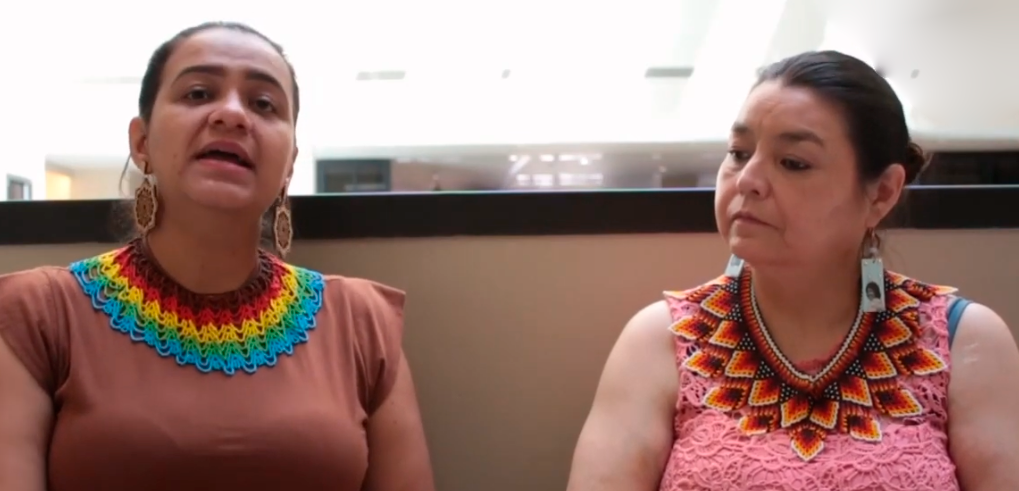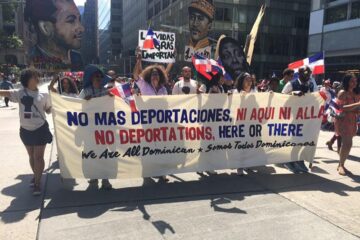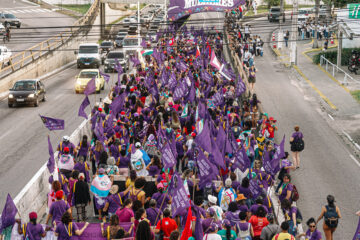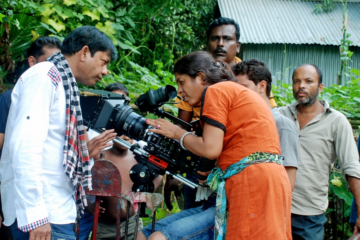Claire Charlo is an Indigenous feminist organizer working for the Indigenous Environmental Network (IEN). Claire is from the Bitterroot Salish people from the Confederated Salish and Kootenai Tribes of the Flathead Reservation in Montana, United States. “We’re living on a reservation with 7,000 tribal members. Unfortunately, the United States government illegally opened up our reservation to settler allotments in 1934. So now, there are more non-Indigenous white settlers on our lands than there are Indigenous people,” she denounced. Claire talked about the relations between IEN’s work and the struggle for Indigenous rights at a global scale: “How my people are impacted in this climate crisis, and how Shyrlene’s people are impacted is different, but we’re going to feel those effects in devastating ways.”
Shyrlene Oliveira da Silva Huni Kuin lives on the Indigenous land Henê Baria Namakia, in Acre state, in the Brazilian Amazon. “The Huni Kuin people has been long struggling and waging numerous battles for the recognition of our culture and mother tongue, Hãxta Kuin.” The Huni Kuin live across 12 territories in Acre state, Brazil, but “the Henê Baria Namakia territory is the only one that has not been demarcated [formally recognized]. It is occupied by 45 families, around 200 people,” Shyrlene explains. In Brazil, the demarcation of Indigenous lands is a right enshrined in the country’s 1988 Constitution.
In this interview, Claire and Shyrlene spoke about unity among different Indigenous peoples in the struggle for rights and against the advances of transnational corporations against their territories. Their discussions are happening in the context of the preparations for the 2025 United Nations Climate Change Conference (COP 30), which will be held in Brazil. This interview was conducted during the Rising Majority Congress, in Saint Louis, United States, in June 2024, which brought together 700 members of several grassroots organizations, parties, unions, and human rights movements in the country, including many members of the Indigenous Environmental Network. Shyrlene was part of the delegation of international observers who attended the congress invited by the Grassroots Global Justice Alliance (GGJ).
Transnational corporations are promoting a global offensive, destroying and taking over Indigenous territories, resources, and cultures. While Indigenous peoples propose paths to stop climate change, businesses push for false solutions. How are Indigenous peoples from different parts of the world coming together to tackle this international offensive?
Shyrlene: The discussion on the financialization of nature and Indigenous peoples’ lives has become extremely important, because, for Indigenous peoples, there is no border between them. The borders and limits have been imposed by states, by countries. Peoples used to move across these territories. Peoples that are now in Peru, Bolivia, across South America, have endured the same impact. So we decided to understand whether those who are in North America, Europe, Asia are faced with the same problems. We came together to wage a struggle for environmental conservation. We believe this is the most just way. The world population has a lot to learn from Indigenous peoples’ ways of life and conservation.
Claire: The Indigenous Environmental Network feels that it’s important to establish relationships with Indigenous people in the global South, so we can help amplify and support their issues while continuing to educate ourselves. My tribe, for example, is not very familiar with false solutions and things like REDD. Carbon offsets have not come to us yet, but we are concerned about other tribes that are economically desperate, and what they see are these companies coming in with money. The problem is that it rarely trickles down to the actual community. These false solutions are basically commodifying Mother Earth, and putting Mother Earth on the auction block to sell. They’re taking the spiritual and the sacredness out of Mother Earth. This is one of the reasons why we have joined with the Huni Kuin: our cosmovision, our vision, our spirituality are in alignment with the fact that our Mother Earth is not for sale.
In the United States, tribal sovereignty is sometimes used as a weapon. I’m speaking about some tribes that choose fossil fuels. They allow fracking and man camps to come into their lands. When they’re building the technology and extracting, sex trafficking goes up, sexual assaults go up, violence goes up during this time. I have several family members that are from a reservation that has been fracked, and now they’re seeing high rates of cancer, miscarriages, autoimmune deficiencies, children are getting fibromyalgia and arthritis, illnesses that are not supposed to happen until maybe you’re extremely old. All of these health problems are coming from the fact that the water has been polluted from the fracking.
Shyrlene: What we have been observing here in our discussions, as we take part in forums and meetings about the parties, is that the principle agreed upon in the International Labor Organization Convention 169 about free, prior, and informed consultation to Indigenous peoples is not being respected. All and any decisions about Indigenous territories must be made after consulting with Indigenous peoples—and not only Indigenous peoples, but also extractivist communities, river-side communities, small family producers, and the lives of other peoples who also live in cities.
Regarding carbon credits, Indigenous communities receive subsidies, payments for results, a compensation for environmental services they provide on the territories where they live. The activities carried out by the populations that occupy protection areas, extractivist reserves, public forests, and Indigenous lands—these “environmental services” are ways of life, not means for compensation. The damages these populations experience and endure on a daily basis with the environmental impacts will never be compensated by big corporations.
How have women and gender-dissident folks been contributing to advance the Indigenous struggle?
Claire: Violence against the land and violence against Indigenous women, femmes, and two-spirit bodies are connected through patriarchy and capitalism. This system devalues women, femmes, and two-spirit by seeing them as a commodity, just how they see the Earth: to just extract, take, and consume. But it’s the Indigenous femmes and two-spirit who are usually on the front lines of land and water resistance camps. I’ve studied over a hundred cases in the United States and Canada, and every single one of them has been started by a woman, a femme, or a two-spirit person. A lot of the times, we’re the ones that are growing the food for our families. This goes back to the role that Indigenous women play in agriculture. Seeds, for example, are passed down for thousands of years, generation to generation. These false solutions, like monocropping and genetic modification of seeds, are coming in to interfere with the Indigenous women’s role in agriculture.
As Indigenous women in the United States, we have this Missing and Murdered Indigenous Women’s Movement. Some of us are saying murdered-missing Indigenous relatives to include other diversities and land defenders from across the globe. In 2023, 77 land defenders in South America were assassinated or murdered for protecting their land. With an exchange with the Huni Kuin people, we learned that this is not just an USA issue.
Shyrlene: Indigenous women face violence when they are on their territories and they don’t have clean water, when they cannot harvest their vegetables, when they don’t have their sacred medicines, when they cannot have their children because they cannot prepare their baths. Their territories are completely contaminated, water is contaminated with mercury and pesticides from nearby farms.
The Indigenous movement’s struggle has been for a long time marked by our warriors, by men, by the chiefs who would struggle in and outside their territories. In recent years, we have been seeing a completely different scenario, in which extremely brave women have been taking the lead in the Brazilian Indigenous movement. These are women of beauty, joy, culture, and so much strength, who know what the Indigenous grassroots movement and the reality of Brazilian Indigenous peoples are. When Indigenous women come together, this movement becomes stronger. This has awaken in the Huni Kuin people in Acre the will to hold the first Indigenous Women’s Forum, two years ago. We gathered more than 200 women leaders in the city of Rio Branco, coming from 118 different villages. It was a historical landmark for the Huni Kuin.
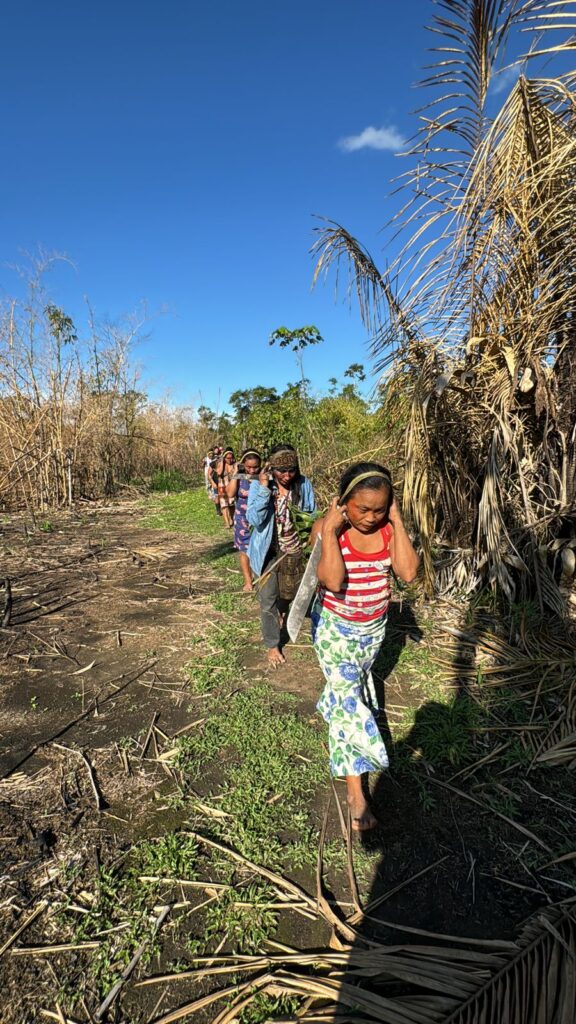
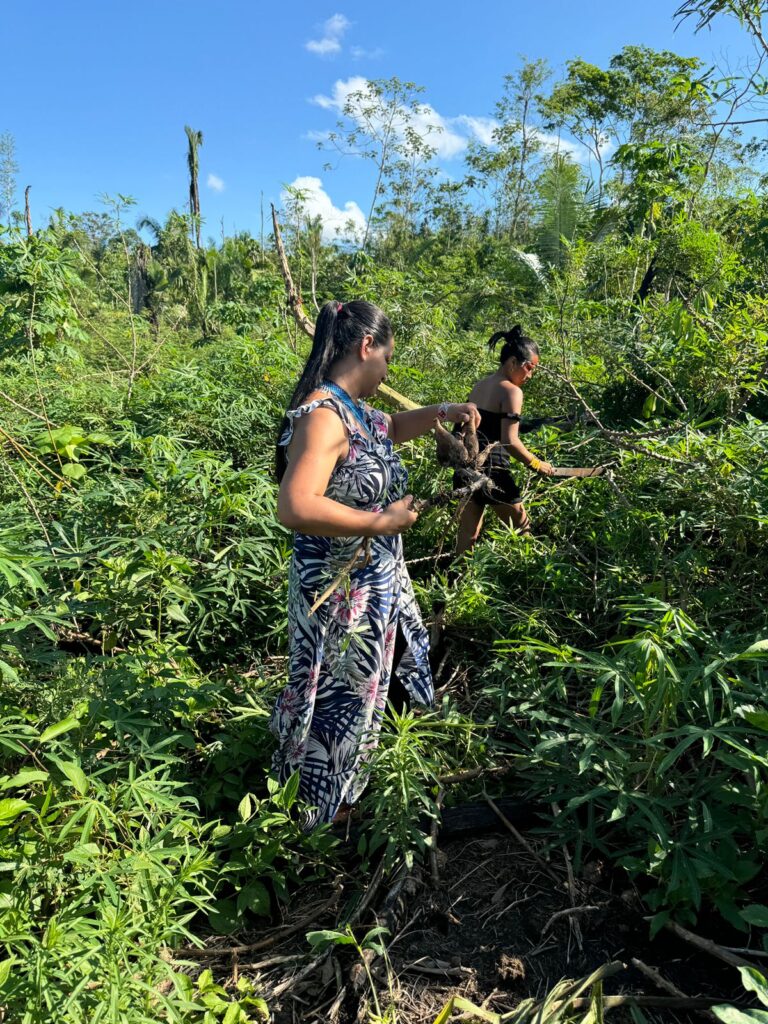
What is your take on the current context and what are the next steps in this struggle that is as local as it is international?
Claire: Things are looking really dire right now. It was 126 ºF (52 °C) in New Delhi last week. That’s too hot for people to be able to survive, and it’s only going to get hotter. I’m seeing all these terrifying reports coming out about the future. But I believe in our Indigenous people and our Indigenous spirituality. We have the answers, the knowledge, and the strength. Being hopeless is a luxury that we can’t afford. Our ancestors have survived apocalypse after apocalypse, and we will survive this.
Shyrlene: The need to study, to leave where I came from to get to where I am, came from knowing that Indigenous people and everyone is in grave danger. The lack of knowledge and information is a warning sign for us. Indigenous people have been struggling with that regarding their worldview, their spirituality, their connection with the beings and spirits. From the moment these beings bring messages, these voices must be echoed. Many spiritual leaders have been talking about the need to heal the soul, relationships, and the Earth, which will then lead to collective healing.

